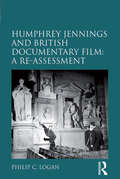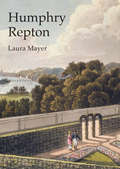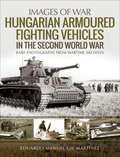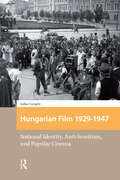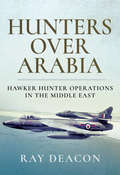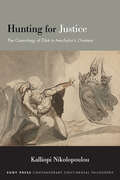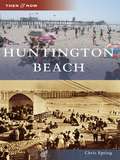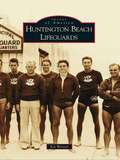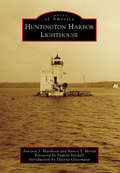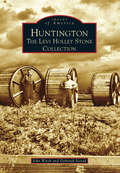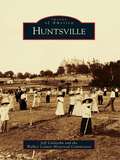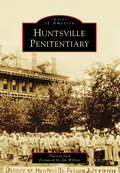- Table View
- List View
Humphrey Jennings and British Documentary Film: A Re-assessment
by Philip C. LoganHumphrey Jennings ranks amongst the greatest film makers of twentieth century Britain. Although a relatively unknown figure to the wider public, his war-time documentaries are regarded by many (including Lord Puttnam, Lindsay Anderson and Mike Leigh) as amongst the finest films of their time. Groundbreaking both in terms of their technique and their interest in, and respect for, the everyday experiences of ordinary people, these films are much more than mere government propaganda. Instead, Jennings work offers an unparalleled window into the British home-front, and the hopes, fears and expectations of a nation fighting for its survival. Yet until now, Jennings has remained a shadowy figure; with his life and work lacking the sustained scholarly investigation and reassessment they deserve. As such film and social historians will welcome this new book which provides an up-to-date and thorough exploration of the relationships between Jennings life, ideas and films. Arguing that Jennings's film output can be viewed as part of a coherent intellectual exercise rather than just one aspect of the artistic interests of a wide ranging intellectual, Philip Logan, paints a much fuller and more convincing picture of the man than has previously been possible. He shows for the first time exactly how Jennings's artistic expression was influenced by the fundamental intellectual, social and cultural changes that shook British society during the first decades of the twentieth century. Combining biography, social history and international artistic thought, the book offers a fascinating insight into Jennings, his work, the wider British documentary film movement and the interaction between art and propaganda. Bringing together assessments of his tragically short life and his films this book is essential reading for anyone with an interest in British cinema or the social history of Britain in the 1930s and 40s.
Humphry Repton
by Laura MayerHumphry Repton (1752-1818) ambitiously styled himself Capability Brown's successor; the century's next great improver of landed property. He believed that the art of laying out grounds could only be achieved by 'the united powers of the landscape painter and the practical gardener', and ingeniously combined his knowledge of farming with a talent for topographical sketching. Over thirty years Repton amassed an incredible four hundred commissions, capitalizing on the whims of the fashion-conscious upper classes left rudderless after Brown's death. Sensitive and snobbish, Repton's ambitions were twofold. He sought to ingratiate himself among the aristocracy, whilst simultaneously raising the status of his adopted profession. Consequently his famous Red Books, illustrated to help clients visualize the potential of their estates, also encouraged an appreciation of landscape aesthetics. This book looks at Repton's theoretic principles and how they underpin his landscape gardening. By detailed site investigations, it traces his approach to landscape design from Picturesque wildernesses like Blaise Castle, Bristol, to the progressive Gardenesque style of Wanstead House in Greater London.
Hundreds and Thousands
by Emily Carr Gerta MorayEmily Carr's journals from 1927 to 1941 portray the happy, productive period when she was able to resume painting after dismal years of raising dogs and renting out rooms to pay the bills. These revealing entries convey her passionate connection with nature, her struggle to find her voice as a writer, and her vision and philosophy as a painter.
Hungarian Armoured Fighting Vehicles in the Second World War (Images of War)
by Eduardo Manuel MartínezThis WWII history vividly captures the Hungarian tanks and military vehicles that fought in Central and Eastern Europe through rare wartime photographs. The Kingdom of Hungary emerged from the Great Depression as a staunch ally of Germany and Italy. In the Second World War, the Central European country not only organized its armed forces in support of the Axis Powers, but also developed its own military industry to supply weapons and equipment to its troops. The Hungarian military produced all kinds of weapons, vehicles and armored vehicles, although they were generally under-gunned and under-armored. This book explores Hungary's participation in the Second World War through superb photographs showcasing its varieties of armored fighting vehicles. Wartime images take the reader from the beginning of the USSR campaign all the way to the bloody Siege of Budapest and the last clashes in Austrian and Slovenian territory before the army's unconditional surrender.
Hungarian Armoured Fighting Vehicles in the Second World War (Images of War)
by Eduardo Manuel MartínezThis WWII history vividly captures the Hungarian tanks and military vehicles that fought in Central and Eastern Europe through rare wartime photographs. The Kingdom of Hungary emerged from the Great Depression as a staunch ally of Germany and Italy. In the Second World War, the Central European country not only organized its armed forces in support of the Axis Powers, but also developed its own military industry to supply weapons and equipment to its troops. The Hungarian military produced all kinds of weapons, vehicles and armored vehicles, although they were generally under-gunned and under-armored. This book explores Hungary's participation in the Second World War through superb photographs showcasing its varieties of armored fighting vehicles. Wartime images take the reader from the beginning of the USSR campaign all the way to the bloody Siege of Budapest and the last clashes in Austrian and Slovenian territory before the army's unconditional surrender.
Hungarian Film, 1929-1947: National Identity, Anti-Semitism and Popular Cinema (Eastern European Screen Cultures)
by Gábor GergelyWhat does it mean for someone or something to be Hungarian? People in Hungary grappled with this far-reaching question in the wake of the losses and transformation brought by World War I. Because the period also saw the rise of cinema, audiences, filmmakers, critics, and officials often looked at films with an eye to that question, too. Did the Hungary seen on screen represent the Hungary they knew from everyday life? And-crucially-did the major role played by Jewish Hungarians in the film industry make the sector and its creations somehow Jewish rather than Hungarian? Jews, it was soon decided, could not really be Hungarian, and acts of Parliament soon barred them from taking major roles in cinema production. This book tells the troubled story of that period in Hungarian cinematic history, taking it up through World War II.
Hunt Club Management Guide: Building, Organizing, and Maintaining Your Clubhouse or Lodge
by J. Wayne FearsIf you ever wanted to create your own hunting club, this book is for you.In Hunt Club Management Guide, wildlife management consultant J. Wayne Fears teaches you how to take your dreams of owning and operating your own hunt club and make them reality. From locating the acres you'll build on to hanging your final set of antlers on the wall, Fears touches on everything you will need to start your own club.In addition to revealing the step-by-step process of organizing and building a great club, Fears also provides insight into maintaining a successful club that will last for decades. This insight includes tips to help:Generate a top-notch wildlife management programPlant and manage food plotsCreate effective rulesDraft contracts and agreementsDevelop quality deer management techniquesAttract deer to your landFrom club by-laws to game management plans, clubhouse to land acquisition, the Hunt Club Management Guide will be your manual for establishing an enjoyable and thriving hunt club.
Hunter's Pajamas
by Tori Telfer Holli CongerHunter is very sad. He’s growing so much, he grew right out of his favorite pair of rocket pajamas! Luckily for him, his aunt makes amazing crafts. He learns you can use your imagination for just about anything—even making patterns for sewing quilts!
Hunters Over Arabia: Hawker Hunter Operations in the Middle East
by Ray Deacon&“Provides an incredible insight into not only the majestic and beautifully lined Hunter, but also to RAF operations in insurgent wars.&” —Flight Line Book Review Based on official records held at the National Archives and other published sources, Hunters over Arabia presents an in-depth account of the operations performed by the Hawker Hunter squadrons policing the desert wastelands and high mountain ranges of the Middle East. Copiously illustrated with color and black and white photographs, a high percentage of operations performed by this versatile British ground attack and reconnaissance fighter are described in detail. Using a chronological format, the narrative focuses on the period during which the Hunter served in the Middle East, from 1960 to 1971. Further chapters are dedicated to the three Hunter variants most closely associated with the Middle East, the FGA.9, FR.10 and T.7, together with their respective allocation dates. A short background to Aden, its historical links to Britain, and RAF airfields administered by Middle East Command complete this factual account. &“Will be referenced for years to come as the authoritative source of operations across the troubled Middle East at the end of British influence.&” —Aircrew Book Review &“Fantastic color and black and white images and beautifully written with great use of National Archive documentation. This book will thrill and inform all enthusiasts of the Hawker Hunter.&” —Vintage Airfix
Hunters in High Heels
by Omar Rodriguez-LopezInternationally celebrated musician/filmmaker Omar Rodríguez-López presents his first book of photographs, a sublime alternative to traditional rock-and-roll imagery OMAR RODRÍGUEZ-LÓPEZ MAY BE BEST KNOWN for his filmmaking and transcendent songwriting/guitar playing with the Mars Volta, At the Drive-In, and other bands, but many people aren’t aware that he is also an exceptional photographer. Hunters in High Heels is Omar’s first book of photographs, comprising photos taken between 2000 and 2006, during which the sheer scope of output and travel undertaken by the Grammy Award–winning musician and his fellow bandmates was nothing short of exhausting. Sharply juxtaposed with typical books of rock-and-roll imagery, Omar’s photographs—all of which were shot on 35mm film—present a more elusive and evocative aesthetic that includes subjects such as highway signage, city skylines, and cloud formations, along with empty arenas and recording studios with friends and colleagues. This body of work provides an intimate glimpse into a specific period in the artist’s life. In her preface to the book, photo editor Stephanie Celaya writes, “Omar is deeply interested in the world . . . an observer of changing landscapes, shifting cultures, and evolving relationships. Omar’s camera has become his touchstone. The combination of his international recognizability paired with his desire for privacy provides a unique and captivating glimpse into his nomadic life. The irony that Omar Rodríguez-López connects to and captures the quietest moments amid, and in between, some of the loudest places is not lost.” Longtime fans of Omar’s music and film will be regaled with the beauty of these photographs, while newcomers will be feted with the sublime visual treasures comprising Hunters in High Heels.
Hunting Dangerous Game: True Tales from Around the World (Outdoor Adventure Library)
by Vin T. SparanoIf you are like most hunters, you probably relish the thought of hunting dangerous game. It’s high adventure, challenge, terror, glamour, all rolled into one face-to-face encounter. Make no mistake-you will also experience fear. Your mouth will run dry, your knees will feel weak, and your hands will shake. You are hunting animals that can hurt and even kill you.These are the stories of hunters and dangerous animals they have channeled. Some hunters did not fare well when it came to that final encounter, but that is what happens when you hunt game that gives no quarter. These tales, dating from the time of Teddy Roosevelt, relate adventures in Alaska, Africa, Malay, Mexico, and other places across the globe. After reading these stories, you will know how it feels to track down a rogue elephant, survive a grizzly attack, face a charging buffalo, and drive an arrow into a brown bear at twenty feet. These classic tales will be sure to make you a bit more apprehensive next time you are in the deep woods.
Hunting and Fishing the Chesapeake: Unforgettable Tales of Wing and Water
by C. L. MarshallFish and fowl make their way to the Chesapeake Bay with the changing seasons, and sportsmen yearn for the hunt. Whether on the wing or water, stories of the chase are integral to life on the Eastern Shore. Thousands of fishermen turn out for the annual White Marlin Open, but not every boat comes close to winning the tournament’s big money. Dedicated hunters brave the Bay on a cold January day to hunt waterfowl on the Pocomoke Sound. Only the most committed fishermen launch a brand-new boat from Saxis Island in the teeth of a summer storm. Join author C.L. Marshall as he weaves humorous and harrowing tales of the sporting life on the Eastern Shore of the Chesapeake.
Hunting for Justice: The Cosmology of Dike in Aeschylus’s Oresteia (SUNY series in Contemporary Continental Philosophy)
by Kalliopi NikolopoulouUtilizes Greek tragedy to investigate the fundamentally arbitrary and violent nature of justice.A purely political understanding of justice does not convey the cosmological origins of the ancient conception of justice, Dikē, in Aeschylus's Oresteia. Drawing from Walter Burkert's anthropology of the hunt in Homo Necans, which articulates an ancient cosmology and implies a theory of (tragic) seriousness that parallels Aristotle's naturalist interpretation of tragedy, Hunting for Justice argues that justice is rooted in predation as exemplified by the Furies. Although the Oresteia has been read as the passage from the violence of nature to civic justice, Kalliopi Nikolopoulou offers an original interpretation of the trilogy: the ending of the feud is less an instance of political deliberation (as Hegel maintained), and more an instance of nature's necessary halting of its own destructiven'ess for life to resume. Extending to contemporary contexts, she argues that nature's arbitrariness continues to underpin our notions of justice, albeit in a distorted form. In this sense, Hunting for Justice offers a critique of the political infinitization and idealization of justice that permeates our current discourses of activism and social justice.
Huntington (Images of America)
by Todd Martin Jeffrey WebbEarly pioneers established Huntington in the 1830s at the site where Miami Indians and French trappers exchanged goods. Because of its location near the Historic Forks of the Wabash, Huntington served as an important transportation hub in the Old Northwest. The Wabash & Erie Canal introduced a wide variety of craftsmen and their families to the area until railroads eventually made canal travel obsolete. After the canal boom and bust, railroads and farming dominated Huntington's economy, but textiles, light manufacturing, and limestone quarries populated the landscape; limestone from Indiana was used to build the Washington Monument in Washington, DC. Some residents went on to achieve national fame, including Congressman Ed Roush, the architect of the 911 emergency response system, and Vice Pres. Dan Quayle. The town is also home to Huntington University, a perennial selection as one of the Midwest's best private colleges.
Huntington (Postcard History Series)
by Patricia J. NovakThe town of Huntington has a documented history that dates back to its founding in 1653. The harbors were principally involved in shipping and shipbuilding, and the lush land was ideal for agriculture. When the railroad arrived in the 1860s and then later the automobile, Huntington, part of the Gold Coast of Long Island, became a destination for city residents looking for an escape to fresh air, beaches, and comfortable surroundings. Stately mansions were built, and the villages bustled with new businesses, entertainment, and architecture. That era has been captured in the postcards sent and collected during that time, adding to the social history of Huntington.
Huntington Beach
by Chris EptingThe 100-year history of Huntington Beach is a rich amalgam of agriculture, oil, surfing, beach culture, aerospace, and small-town America. This comparative, visual evolution of the city is crafted for both locals and tourists alike, featuring some of the most defining views ever captured of Surf City, USA®.
Huntington Beach Lifeguards
by Kai WeisserThe Surf City USA® lifeguards and marine safety officers protect and serve one of the busiest and most famous beaches in the world. World-class surfing events, volleyball tournaments, and other activities transform Huntington Beach's waterfront into a sea of humanity regularly each summer. The lifeguards patrol three and a half miles of beautiful wide, sandy Orange County shores, which can draw more than 10 million annual visitors, necessitating as many as 3,000 rescues. The ultimate lifeguard sentinel and guardian is the iconic structure on the HB Municipal Pier called Tower Zero, known as "The Eye in the Sky," from which lifeguards can see for miles. These vintage photographs include shots of the pier, beach, junior lifeguard activities, competitions, and neighboring Huntington State Beach. Thousands of people and families owe gratitude to the lifeguards of Huntington Beach for nearly a century of vigilance, dedication, and service.
Huntington Beach, California
by Chris EptingIncorporated in 1909, Huntington Beach remained a sleepy seaside town until the city's legendary oil boom in the 1920s. Wells sprang up overnight, and in less than a month, the city's population more than doubled. As the area developed culturally through the decades, the once tiny farming community increased its size with 25 miles of annexations to become one of Southern California's major tourist destinations. Pictured here in nearly 200 vintage photographs is the evolution of this small seaside village into a classic, Southern California beach city, known as Surf City to nearly a million tourists a year. Showcased here are images acquired from city records, including shots of the famous Huntington Beach Pier as it evolved over the century, rare amateur photos of one of the largest gushers in city history, vintage beach scenes, rarely seen historic aerial views, images of the turn of the century "Tent City," the infamous flood of 1938, and nostalgic shots of the Saltwater Plunge.
Huntington Beach: California (Postcard History)
by Chris Epting Marvin CarlbergFor more than 100 years, Huntington Beach has been a scenic haven for locals and tourists alike. Huntington Beach has also been the subject of many postcards. After all, "Surf City, USA" is a wonderfully picturesque place. Compelling printed images of the famous pier, downtown, the parks, people, agriculture, and businesses became some of the city's most popular souvenirs. Postcards such as these evoke the magic of long-gone summers; wistful, nostalgic glimpses of a classic Southern California beach city--and they are just as lovely today as they were decades ago.
Huntington Harbor Lighthouse (Images of America)
by Antonia S. Mattheou Nancy Y. MoranIn the early days, Huntington, New York, was known as part of the Gold Coast of Long Island. It was a busy area boasting summer hotels and docking facilities. Steamboats brought crowds to Huntington from New York City for outdoor fun. Mariners took advantage of landmarks to guide their craft into channels until 1857, when the Lloyd Harbor Light Station was built on a sandspit to guard the entrance of both Lloyd and Huntington Harbors. In 1907, the US Congress appropriated $40,000 for the construction of a new lighthouse to replace the Lloyd Harbor Light Station, which proved to be ineffective for the navigation of vessels entering Huntington Harbor. The Venetian Renaissance-style structure was completed in 1912 and had the distinctive appearance of a small castle. Thanks to the enormous efforts of the Huntington Lighthouse Preservation Society, Inc., the beauty and uniqueness of the Huntington Harbor Lighthouse has been preserved.
Huntington: The Levi Holley Stone Collection
by John Witek Deborah NovakA flea market discovery that became an art museum sensation, this collection of photographs by Levi Holley Stone presents the city of Huntington, West Virginia, as it has never seen before. Stone's lens reveals a city of contrasts: a blend of broad boulevards and crumbling alleys, a mix of monuments and mud. It is a place where cars share the road with horses, roughnecks loiter in pool halls, and theatergoers enjoy extravagant musicals direct from Broadway. Newcomers flocked to this commercial hub on the Ohio River, and Stone's images of steamboats, trains, and motorcars show how they traveled. He captured the river, too, when it was frozen enough to walk across and furious enough to drown the city more than once. Stone was born in Huntington in 1898, and he photographed his hometown obsessively. Even his closest friends never knew that the photographs they took for granted were sensitive works of art.
Huntley (Images of America)
by Nancy S. BachellerHuntley was founded in 1851. Its first boom years--the 1850s to 1920s--saw the town prosper thanks to the local dairy industry. Prolific dairy farmers provided milk for the many local condensing plants and cheese factories and sent huge surpluses into Chicago by train each day. It was said that the Huntley area produced more milk per square mile than anywhere else in the world. Businesses, homes, and churches all grew with the population. Village founders, movers and shakers of a century and more ago, as well as everyday workers and village residents are captured here in vintage images, showing what life was like in Huntley in years gone by.
Huntsville
by Jeff Littlejohn Walker County Historical CommissionHuntsville is one of the oldest and most revered cities in the Lone Star State. Founded in the mid-1830s as Texans won their independence from Mexico, Huntsville became the home of Sam Houston--the first president of the Republic of Texas and later governor of the state. Nestled among the lakes and trees of the eastern piney woods, Huntsville emerged as a vital center of education and justice in the late 19th century. Today the city remains a vibrant, growing community known for a few of its largest employers, including Sam Houston State University and the Texas Department of Criminal Justice.
Huntsville Penitentiary (Images of America)
by Jim Willett Theresa JachThe state of Texas, home to one of the largest prison systems in the country, opened its first penitentiary in 1849. The Walls Unit in Huntsville was the genesis of a prison system that became the home of notorious convicts and the focus of much debate about incarceration and the death penalty in the United States. The Walls Unit housed gunslinger John Wesley Hardin, members of the Clyde Barrow and Bonnie Parker gang, and infamous drug cartel leader Fred Carrasco. Built using convict labor, the Walls Unit was heralded as a modern approach to incarceration in Texas. The prison dominated the landscape of the town of Huntsville when it was built and remains central to that community today.
Huntsville Textile Mills & Villages: Linthead Legacy (Landmarks)
by Terri L. FrenchIn the early 1900s, Huntsville, Alabama, had more spindles than any other city in the South. Cotton fields and mills made the city a major competitor in the textile industry. Entire mill villages sprang up around the factories to house workers and their families. Many of these village buildings are now iconic community landmarks, such as the revitalized Lowe Mill arts facility and the Merrimack Mill Village Historic District. The "lintheads," a demeaning moniker villagers wore as a badge of honor, were hard workers. Their lives were fraught with hardships, from slavery and child labor to factory fires and shutdowns. They endured job-related injuries and illnesses, strikes and the Great Depression. Author Terri L. French details the lives, history and legacy of the workers.
